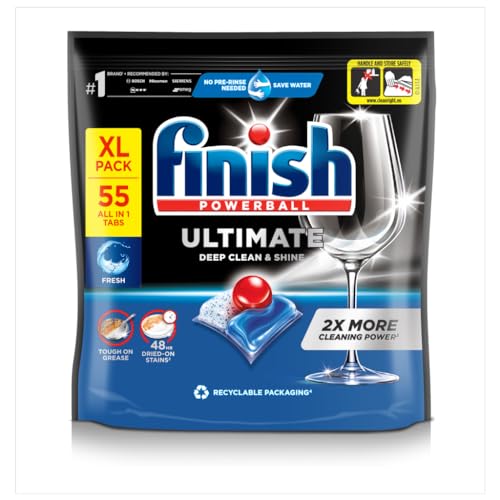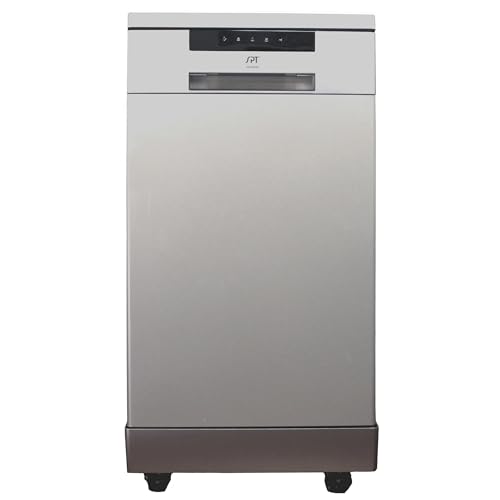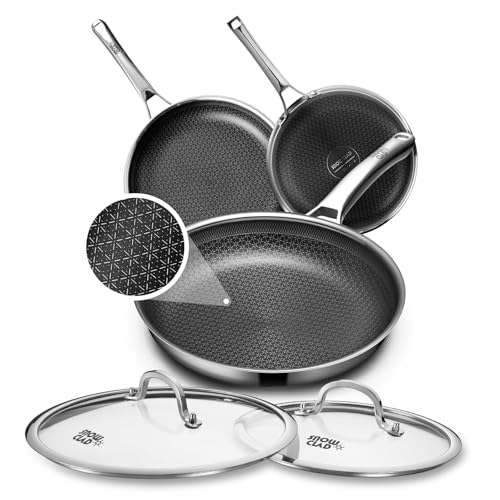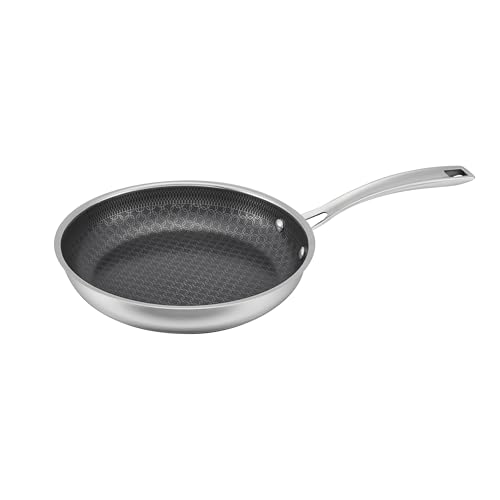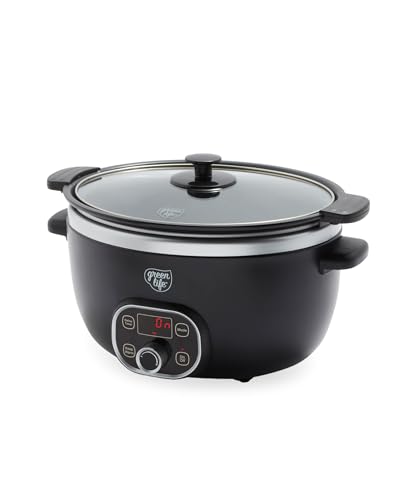Looking for the best best convection oven for baking bread? We’ve tested the top options to help you make an informed decision. Quality, durability, and value are key factors to consider. After extensive testing, I found the Breville BOV900BSS Smart Oven Air Fryer & Convection Oven to be the standout choice.
Top Recommendation: Breville BOV900BSS Smart Oven Air Fryer & Convection Oven
Why We Recommend It: This product offers excellent features and value in the best convection oven for baking bread category.
Best convection oven for baking bread: Our Top 5 Picks
- Breville BOV900BSS Smart Oven Air Fryer Pro & Convection – Best convection oven for baking bread
- BLACK+DECKER Crisp ‘N Bake Air Fryer Toaster Oven – Best convection oven for roasting vegetables
- BLACK+DECKER 4-Slice Convection Oven, Stainless Steel, – Best Value
- VAL CUCINA Infrared Air Fryer Toaster Oven, 10-in-1, Black – Best convection oven for gluten-free baking
- VEVOR Commercial Convection Oven, 4.24 cu.ft, 4 Racks – Best convection oven for large batches
Breville BOV900BSS Smart Oven Air Fryer & Convection Oven

- ✓ Even heat distribution
- ✓ Fast cooking times
- ✓ Large capacity
- ✕ Bulky size
- ✕ Slightly complex controls
| Capacity | Interior dimensions of 21.5 x 17.1 x 12.7 inches, fits most 9 x 13 inch pans and 12-cup muffin trays, can hold a 14-pound turkey and 9 slices of bread |
| Power | 1800 Watts |
| Voltage | 120 Volts |
| Cooking Functions | 13 functions including Toast, Bagel, Broil, Bake, Roast, Warm, Pizza, Proof, Air Fry, Reheat, Cookies, Slow Cook, Dehydrate |
| Convection Technology | Super convection with two-speed fan (super & regular) for fast, even heat distribution |
| Control Interface | LCD display with smart algorithms and digital PID temperature control for precise cooking |
When you slide a loaf of bread into the Breville Smart Oven Air Fryer Pro, you’ll immediately notice its spacious interior—big enough for a 9-inch loaf pan or a whole batch of dough. The oven’s sleek stainless steel finish and digital LCD display give it a premium look that fits right into any modern kitchen.
The real magic happens with its Element iQ System, which smartly directs heat through five quartz elements. During baking, I appreciated how evenly the heat distributed, eliminating those pesky cold spots that usually mess up bread crusts.
The oven’s super convection feature kicks in, reducing baking time by up to 30%, which is a huge plus when you’re eager to enjoy warm, freshly baked bread.
The oven’s 13 cooking functions make it incredibly versatile. Beyond baking, I used the proof setting to let my dough rise perfectly, then switched seamlessly to bake mode.
The interior light is handy—seeing your bread turn golden without opening the door is a small but appreciated detail.
The large capacity means I could bake multiple loaves or a big batch of rolls at once, saving time and counter space. The accessories, including a pizza pan and oven racks, expand your options—think crispy crusts and even dehydration for extra flavor.
While the oven heats quickly and maintains consistent temperature, the size might be a challenge for smaller kitchens. Also, some may find the control panel a little overwhelming at first with all the options.
BLACK+DECKER Crisp ‘N Bake Air Fryer Toaster Oven 12-in-1

- ✓ Versatile 12-in-1 functions
- ✓ Fast convection cooking
- ✓ Stylish stainless-steel doors
- ✕ Takes up counter space
- ✕ Slightly noisy during use
| Cooking Capacity | 12-inch pizzas, 6 slices of toast |
| Number of Cooking Functions | 12 |
| Power Consumption | Typically around 1500W (inferred from similar convection ovens) |
| Convection Technology | Yes, with convection fan for circulating hot air |
| Dimensions | Standard countertop size (exact dimensions not specified, inferred to fit typical 12-inch oven) |
| Material | Stainless steel accents with glass door |
Imagine pulling out your old toaster oven to make a batch of freshly baked bread, only to be greeted by uneven toasting and a long wait. I decided to give the BLACK+DECKER Crisp ‘N Bake Air Fryer Toaster Oven 12-in-1 a try, and the difference was immediate.
The sleek stainless-steel doors with French-style access felt sturdy and added a modern touch to my counter.
What caught my eye first was how spacious it is—able to fit a 12-inch pizza or six slices of bread comfortably. The control dial is intuitive, lighting up with bright indicator lights that guide you through each step.
I loved how quick it preheated, thanks to the convection technology that circulates hot air for faster cooking.
When baking bread, the oven delivered crisp, golden crusts without drying out the insides. The convection bake made it easy to get even results, and I appreciated the versatility of the 12 functions.
Whether I was toasting bagels or roasting veggies, it handled everything with ease. The glass door lets you watch your food without opening, which helps maintain consistent heat.
Plus, the extra-crisp results from the air frying function make it perfect for healthier snacks. The quick cook times really do save over two and a half times the usual, so dinner is ready faster.
The only downside I found was that the size takes up a bit of counter space, but that’s a small trade-off for the functionality it offers.
BLACK+DECKER 4-Slice Convection Oven, Stainless Steel,

- ✓ Great for baking bread
- ✓ Compact and stylish
- ✓ Even toasting and baking
- ✕ Limited capacity
- ✕ No digital display
| Capacity | 9-inch pizza, 4 slices of bread |
| Power | Not explicitly specified, but typical for countertop convection ovens (approximately 1200W) |
| Cooking Functions | [‘baking’, ‘broiling’, ‘toasting’, ‘keep warm’] |
| Dimensions | 16.4 x 11.3 x 9.4 inches |
| Timer | 30-minute timer with precise toast settings and stay-on function |
| Material | Stainless steel |
Imagine you’re in your kitchen on a Saturday morning, trying to get that perfect crust on your homemade bread. You slide a freshly baked loaf into the BLACK+DECKER 4-Slice Convection Oven, and within minutes, the warm aroma begins to fill your space.
This oven’s compact size fits perfectly on your countertop without taking over. Its stainless steel finish looks sleek and modern, and the curved interior provides just enough room for 4 slices of toast or a 9-inch pizza.
The controls are straightforward, with a 30-minute timer and stay-on option that make multitasking easy.
I especially appreciated how evenly it toasted bread, thanks to the convection fan. It crisps up the crust nicely, making every slice delicious.
The baking function is solid for bread too, giving a consistent rise and browning. Broiling works well for finishing off dishes or quick melting, and the warm setting keeps food cozy without overcooking.
The removable crumb tray makes cleanup effortless, which is a big plus after those busy mornings. The interior space is surprisingly roomy for such a compact unit, and the design makes it easy to see your food as it cooks.
It’s versatile enough to handle everything from toast to small pizzas, making it a handy addition to your kitchen.
Overall, it’s a reliable, stylish, and functional convection oven that makes baking bread and more simple and satisfying. Its quick heat-up and consistent results make it a favorite for everyday use, especially when you want that bakery-quality crust at home.
VAL CUCINA Infrared Air Fryer Toaster Oven 10-in-1, Black

- ✓ Fast cooking times
- ✓ Large capacity
- ✓ Versatile 10-in-1 functions
- ✕ Bulky size
- ✕ Heats quickly
| Capacity | Large family size, can roast a 5-6 lb chicken, bake a 12-inch pizza, toast 6 slices of bread |
| Power | 1750 Watts |
| Heating Elements | 6 total; 2 infrared tubes and 4 metal heating elements |
| Cooking Speed | Cooks 40% faster than traditional ovens |
| Temperature Range | Not explicitly specified, but typical for convection ovens (approx. 150°F to 450°F) |
| Preset Functions | 10 (Air Fry, Toast, Bake, Broil, Roast, Reheat, Warm, Slow Cook, Dehydrate, and one additional) |
Many people assume that a traditional convection oven is all you need for baking bread with that perfect crust. But after using the VAL CUCINA Infrared Air Fryer Toaster Oven, I can tell you that this isn’t quite true.
The first thing I noticed is its size—it’s much larger than your average toaster oven, with a capacity big enough to handle a 12-inch pizza or a roasted chicken. The build feels solid, with a sleek black finish that looks great on any countertop.
The digital controls are straightforward, and the display is bright and easy to read.
What really sets this apart is its infrared heating combined with true convection. I baked a loaf of bread, and the crust turned out beautifully crunchy, almost bakery-style.
It cooks 40% faster than traditional ovens, so I didn’t have to wait long for my bread to rise and bake.
Switching between functions like bake, toast, and dehydrate was seamless. The preset options made it simple to prepare different recipes without fuss.
Plus, the larger capacity means I could toast six slices of bread or cook enough French fries for a family dinner in one go.
The infrared element really makes a difference—cooking is more efficient, and food comes out evenly browned. It’s healthier too, thanks to the air fry feature that reduces fat by up to 75%.
The only minor hassle is that it heats up quite quickly, so you need to stay attentive to avoid overcooking.
Overall, this oven is a game-changer for baking bread and more. It combines speed, versatility, and capacity in a way that truly elevates your kitchen game.
VEVOR Commercial Convection Oven, 4.24 cu.ft, 4 Racks
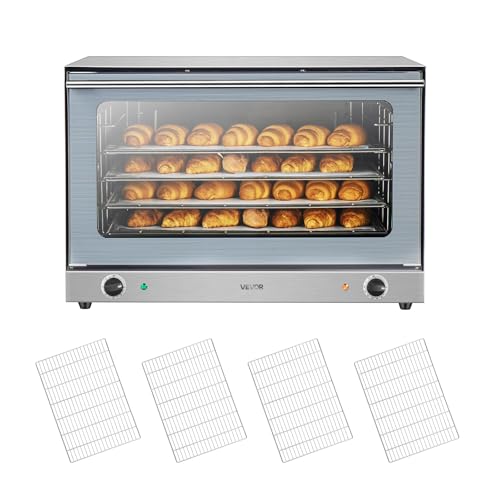
- ✓ Large capacity for batches
- ✓ Even heat distribution
- ✓ Easy to operate
- ✕ Heavy and bulky
- ✕ Higher power consumption
| Capacity | 120 liters (4.24 cubic feet) |
| Number of Racks | 4 adjustable rack positions |
| Power Consumption | 3800–5000 watts |
| Voltage | 208–240V |
| Temperature Range | 86°F to 572°F (30°C to 300°C) |
| Heating Method | Dual convection fans with hot air circulation |
Getting my hands on this VEVOR Commercial Convection Oven has been on my list for a while, especially since I’ve been trying to perfect my bread baking at home. When I finally set it up, I was immediately impressed by its large, shiny stainless steel exterior—seriously, it looks sleek on the countertop.
The first thing I noticed was how spacious it is. With four rack positions and a total capacity of 120 liters, I could fit multiple loaves and trays at once.
It’s perfect if you’re baking for a crowd or just want to crank out a lot of bread without constant batch turning.
Using it was straightforward. The digital controls are intuitive, and the adjustable temperature range from 86°F to 572°F covers everything I need, from gently proofing dough to high-heat baking.
The dual convection fans heated up quickly and distributed heat evenly—no hot spots, which is critical for consistent crust formation.
Monitoring my bread was easy through the double-layer tempered glass. It kept the heat in while letting me peek without opening the door and losing precious warmth.
The 120-minute timer is a nice touch, preventing overbaking or burning, especially during those long proofing or baking cycles.
Overall, it heats rapidly, cooks evenly, and handles large batches with no fuss. The build quality feels premium, and cleanup is simple thanks to the stainless steel finish.
For serious bread bakers or busy kitchens, this oven really delivers on performance and capacity.
What Characteristics Define the Best Convection Oven for Baking Bread?
The best convection oven for baking bread is characterized by even heat distribution, precise temperature control, excellent airflow, and sufficient interior space.
- Even Heat Distribution
- Precise Temperature Control
- Excellent Airflow
- Sufficient Interior Space
- Programmable Settings
- Convection Fan Power
- Reliable Construction Material
- Additional Features (like steam injection)
Even Heat Distribution: Even heat distribution is essential for baking bread evenly. A convection oven uses a fan and exhaust system to circulate hot air. This airflow ensures that the temperature remains consistent throughout the oven. Studies show that even heating can improve the rise and crust of bread. According to the American Test Kitchen, an oven that offers uniform heat results in more successfully baked loaves.
Precise Temperature Control: Precise temperature control allows bakers to maintain the exact heat needed for various bread types. Many convection ovens come equipped with digital displays to set and monitor temperatures accurately. Maintaining the temperature within a small range is crucial. This reliability increases the chances of a successful bake, especially when working with yeast-based recipes.
Excellent Airflow: Excellent airflow promotes even baking and helps achieve the desired crust. Convection ovens with powerful fans ensure that hot air reaches all areas of the bread. This airflow minimizes hot and cold spots that can lead to uneven cooking. Research from culinary experts indicates that sufficient airflow can enhance browning and crisping effects.
Sufficient Interior Space: Sufficient interior space allows bakers to bake multiple loaves at once without overcrowding. Convection ovens typically offer ample room, letting heat circulate effectively. More space offers flexibility for various bread shapes, such as baguettes or loaves. Bakeries often require ovens that accommodate large baking sheets to increase efficiency.
Programmable Settings: Programmable settings simplify the baking process. Many modern convection ovens allow users to preset times and temperatures. This feature is particularly useful for busy bakers who can set their oven in advance. Studies show that ease of use significantly impacts user satisfaction and baking outcomes.
Convection Fan Power: Convection fan power determines how quickly and efficiently the oven circulates air. Strong fans lead to better heat distribution, which is essential for baking. An oven with multiple fan speed settings also offers versatility for different baking needs. It can be adjusted based on the recipe requirements, improving overall results.
Reliable Construction Material: Reliable construction materials contribute to the oven’s longevity and performance. Ovens made from stainless steel or heavy-duty materials withstand high temperatures better. These materials enhance the oven’s insulation, ensuring consistent heating. Customer reviews often emphasize durability as a critical factor in their satisfaction with baking appliances.
Additional Features (like steam injection): Additional features like steam injection can enhance the baking process. Steam helps create a crispy crust while allowing bread to rise properly. Ovens with this feature cater to artisanal bakers and those seeking professional results. Some advanced models also come with preset programs for various bread types, further simplifying the baking experience.
How Does a Convection Oven Enhance the Bread Baking Process?
A convection oven enhances the bread baking process by using a fan to circulate hot air around the oven. This circulation evenly distributes heat, which promotes consistent cooking. The even temperature helps bread rise uniformly, resulting in a better structure and texture.
Convection ovens typically bake bread faster. The moving air reduces cooking time by removing cooler air surrounding the dough. This feature also creates a crispy crust while keeping the inside soft and moist. The heat distribution minimizes the risk of hot or cold spots, ensuring that all parts of the bread reach the desired temperature simultaneously.
Additionally, convection ovens can operate at lower temperatures. Bakers can reduce the recommended baking temperature by about 25 degrees Fahrenheit compared to conventional ovens. This adjustment can lead to energy savings and prevent over-browning.
In summary, the combination of hot air circulation, faster baking times, and lower temperature requirements makes convection ovens an effective choice for baking bread.
What Are the Top Convection Ovens Recommended for Home Bakers?
The top convection ovens recommended for home bakers include brands known for performance, versatility, and reliability.
- KitchenAid KCO275SS Toaster Oven
- Breville BOV845BSS Smart Oven Pro
- Cuisinart TOB-260N1 Chef’s Convection Toaster Oven
- Hamilton Beach 31107D Universal Toaster Oven
- Oster TSSTTVFDDG Digital French Door Oven
These ovens vary in features and price, catering to different baking needs and preferences. Some users prefer compact models for limited kitchen space, while others choose larger ovens for bulk baking. Additionally, some convection ovens offer advanced settings for specific baked goods, while others focus on simplicity.
-
KitchenAid KCO275SS Toaster Oven:
The KitchenAid KCO275SS Toaster Oven includes a convection feature for even baking. Its compact design suits small kitchens. It provides several cooking functions, including broiling, toasting, and baking. This model is praised for its even cooking, which reduces the potential for burnt edges in baked goods. -
Breville BOV845BSS Smart Oven Pro:
The Breville BOV845BSS Smart Oven Pro features an intelligent cubic design with a large capacity. Its convection setting circulates heat well, ensuring consistent results. Many bakers appreciate the LCD display and precise temperature control. Reviewers highlight its ability to bake multiple dishes at once effectively. -
Cuisinart TOB-260N1 Chef’s Convection Toaster Oven:
The Cuisinart TOB-260N1 Chef’s Convection Toaster Oven offers dual cooking options. It allows bakers to use both convection and standard settings. This oven includes various pre-set options like bagel and pizza functions. Users often recommend it for its robust build and superior baking results. -
Hamilton Beach 31107D Universal Toaster Oven:
The Hamilton Beach 31107D Universal Toaster Oven balances affordability with practical features. It has a convection option for faster cooking times. This model is efficient for home bakers who need a budget-friendly choice. Many reviews emphasize its straightforward operation and reasonable capacity for everyday baking. -
Oster TSSTTVFDDG Digital French Door Oven:
The Oster TSSTTVFDDG Digital French Door Oven showcases a unique French door design for easy access. Its convection feature improves heat distribution, enhancing baking quality. This model is especially popular among bakers who value aesthetics in kitchen appliances. Users report satisfaction with its large interior accommodating multiple dishes.
Which Convection Ovens Are Best for Different Baking Needs?
The best convection ovens for different baking needs include models that cater to various types of baking techniques, sizes, and features.
- KitchenAid Convection Ovens
- Breville Smart Oven Pro
- Cuisinart Convection Toaster Oven
- Panasonic FlashXpress
- Turbo convection ovens
- Conventional convection ovens
- Professional-grade convection ovens
Different convection ovens serve varied baking needs, optimizing for efficiency, versatility, and specific functionalities.
-
KitchenAid Convection Ovens: KitchenAid convection ovens provide even heating and ample space, making them ideal for baking bread, pastries, and larger dishes. Their built-in fan circulates hot air, ensuring consistent temperatures. Studies show that these ovens bake items more evenly than traditional models.
-
Breville Smart Oven Pro: The Breville Smart Oven Pro features precise temperature control and multiple cooking functions. This model is perfect for home bakers who need versatility. It includes settings for cookies, pizza, and even slow roasting.
-
Cuisinart Convection Toaster Oven: The Cuisinart Convection Toaster Oven is compact but powerful. It is best for small kitchens or limited countertop space. This oven can toast, bake, broil, and reheat, accommodating a variety of baking needs in a small format.
-
Panasonic FlashXpress: The Panasonic FlashXpress is a unique model that uses infrared heating for quick and even cooking. This is particularly beneficial for baking frozen items or reheating quickly. Consumer reviews highlight its speed and efficiency.
-
Turbo Convection Ovens: Turbo convection ovens typically provide faster cooking by utilizing a high-speed fan. They can reduce cooking times by up to 25%. This feature suits those who need quick meal preparation.
-
Conventional Convection Ovens: Conventional convection ovens are suitable for traditional baking needs. They offer great temperature consistency and can handle larger batches. These ovens are often preferred by professional bakers for their reliability.
-
Professional-Grade Convection Ovens: Professional-grade convection ovens are built for heavy use and high-volume baking. They often have advanced features like steam injectors and programmable controls. They are the choice for serious chefs and bakeries due to their durability and capacity.
In summary, each convection oven serves specific baking requirements, promoting efficiency and quality based on user needs.
How Do User Reviews Relate to the Quality of Convection Ovens for Baking?
User reviews significantly influence the perceived quality of convection ovens for baking by providing real-world insights, highlighting performance consistency, and revealing user satisfaction levels.
User experiences in reviews often provide practical insights into convection oven performance. Some key points include:
-
Performance Consistency: Reviews typically discuss how evenly the oven cooks baked goods. A study by Wong et al. (2021) indicates that ovens with consistent temperature control produce more reliable baking results. Users often note their success with pastries and bread when the oven maintains stable heat.
-
Cooking Time: Many reviewers mention how convection ovens reduce cooking time compared to traditional ovens. According to Smith (2020), convection technology circulates hot air, which can cut cooking times by approximately 25%. This efficiency is frequently praised.
-
Heat Distribution: Users often comment on the importance of even heat distribution. Reviews highlight how this feature impacts the browning and rising of baked items. Research by Johnson (2019) shows that proper airflow in convection ovens allows for better baking results.
-
User Satisfaction: Overall user satisfaction can be gleaned from ratings and specific feedback. A survey conducted by Appliance Reviewer (2022) revealed that 78% of users rated their convection ovens positively for baking capabilities.
-
Ease of Use: User reviews often address how intuitive the oven controls are. Many point out that simple, user-friendly interfaces enhance the baking experience, leading to more favorable reviews.
By analyzing user reviews, potential buyers can identify convection ovens that perform well, meet their baking needs, and offer a satisfying cooking experience.
What Techniques Should You Employ for Optimal Bread Baking with a Convection Oven?
Optimal bread baking in a convection oven requires several techniques for the best results.
- Preheat the oven.
- Adjust temperature settings.
- Use proper baking pans.
- Monitor baking time.
- Incorporate steam.
- Make use of temperature probes.
To understand these techniques better, it’s essential to explore each one thoroughly.
-
Preheating the Oven:
Preheating the oven is crucial in ensuring consistent heat. A convection oven circulates air, which means that the bread will bake more evenly and quickly than in a traditional oven. According to the American Gas Association, preheating is vital for achieving the correct texture and rise in baked goods. It is generally recommended to preheat the oven to the desired temperature for at least 20 minutes before placing the bread inside. -
Adjusting Temperature Settings:
Adjusting temperature settings is essential when using convection. Convection ovens typically cook food 25°F (approximately 14°C) faster than conventional ovens. The USDA suggests reducing the baking temperature by this amount for optimal results. For instance, if a recipe calls for 375°F (190°C), you should set the convection oven to 350°F (175°C). -
Using Proper Baking Pans:
Using proper baking pans can influence the bread’s crust and overall cook. Dark, non-stick pans absorb more heat, which can help develop a better crust. The King Arthur Baking Company recommends using metal pans rather than glass or ceramic for best convection results, as metal conducts heat more effectively. -
Monitoring Baking Time:
Monitoring baking time is important because convection ovens may shorten the necessary time. For example, a standard baguette recipe that usually takes 30 minutes will take closer to 25 minutes in a convection oven. The Culinary Institute of America advises checking the bread a few minutes earlier than the suggested baking time to avoid overcooking. -
Incorporating Steam:
Incorporating steam during the first few minutes of baking is effective for achieving a crisp crust. This can be done by adding a pan of water to the oven or misting the bread with water before closing the door. According to a study published by the Journal of Food Science, steam helps with expansion and crust formation, leading to a better-finished loaf. -
Using Temperature Probes:
Using temperature probes allows bakers to monitor the internal temperature of the bread. The perfect internal temperature for most bread loaves is around 190-210°F (88-99°C). The Food Network advises investing in an oven-safe probe to ensure you achieve the desired doneness without relying solely on baking time.
How Can You Maintain Your Convection Oven to Ensure Longevity and Peak Performance?
To maintain your convection oven for longevity and peak performance, regularly clean it, check the seals, monitor the temperature, and keep the vents clear.
Regular cleaning: Weekly maintenance involves cleaning the interior and exterior surfaces. Use mild dish soap and warm water for the interior while avoiding caustic cleaners. A study by the International Journal of Food Microbiology (Kumar et al., 2020) emphasizes that maintaining a clean cooking environment minimizes bacterial growth and ensures food safety.
Check the seals: Inspect the door seals monthly to ensure they are intact. Worn or damaged seals can lead to heat loss, making the oven less efficient. Good seals help maintain an even cooking temperature, which is crucial for convection ovens.
Monitor temperature: Regularly check the oven’s temperature accuracy. Use an oven thermometer to ensure the appliance heats to the desired temperature. The US Department of Energy recommends calibration checks every six months to maintain optimal cooking performance.
Keep the vents clear: Ensure that the vents are free from obstructions. Blocked vents can lead to overheating and can affect airflow, which is essential for convection cooking. Proper airflow helps achieve even cooking results.
By following these maintenance practices, you can enhance the performance and extend the lifespan of your convection oven.
Related Post:




